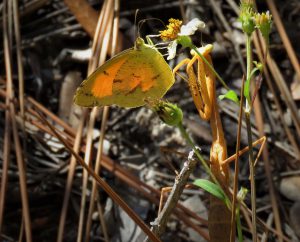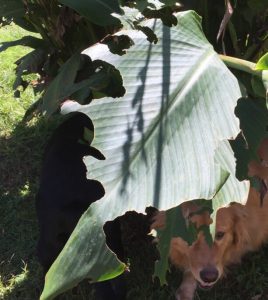An up close view reveals dozens of hairy, inch long caterpillar, twitching within the fine webbing. Twigs, stems, skeletonized leaves and excrement were visible. Left alone, will these fall webworm kill our young pecan tree? Is this a pest requiring treatment?
What is a pest?
The answer varies from person to person. Broadly defined, a pest competes with human, domestic animals or desirable plants for food or water. A pest may injure or spread disease to human, animals, desirable plant, structures or possessions. Pests can be insects or insect-like organisms, microbial organism, vertebrates, mollusks and weeds.
Generally speaking, managing yard pests responsibly involves a number of strategies.
Regular Scouting.
Monitor early to prevent or reduce potential disease or insect pest problems. Insect pests are easier to manage when immature and fewer in number. Proper identification is key to determining if and when something should be done.
Do you enjoy seeing butterflies in your landscape? Many people do. However, when citrus leaves are consumed by giant swallowtail butterfly larvae, we reconsider the benefit. Are a few butterfly larvae going to kill a healthy mature citrus? Probably not.

Appreciate the “good guys.”
Natural control of pest populations comes in the form of wasp, fly, beetle, bird and other species. These good guys feed directly upon, lay their eggs on, or in, pest insects.
Plant diversity and shelter will invite beneficial insects. Want herbs and plants that attract beneficial insects? Contact me for a factsheet. Identify and determine if it’s a pest or beneficial in the landscape. ENY-822, Natural Enemies and Biological Control, is one of a series from the Department of Entomology and Nematology, UF/IFAS Extension.
Drippin’ with culture.
Stressed plants are susceptible to insect pressure. Water plants appropriately. Roots are primary structures for water and dissolved nutrient uptake. Reduce likelihood of leaf fungal disease by directing water to the soil and keeping leaves dry.
Likewise, excess fertilization may stimulate vegetative growth. This flush of growth is like ringing the dinner bell. Aphid and scale easily pierce and suck life juices from tender new growth. As a result, when mature, leaves are curled, puckered and distorted. Too late to treat as aphid are long gone.
Plant warm season vegetables late enough to avoid frost and harvest before height of insect and disease pressure to reduce chemical dependency. UF’s Vegetable Gardening publication provides approximate planting dates and recommended varieties.

Manual control.
Is cutting the caterpillar in half an option for the home gardener? Severed from the body, the business end of tomato horn worm shall not live. Or, remove the offender and toss it in bucket of soapy water?
Along that vein, are sacrificial plants an option? Gently relocate caterpillars to crops planted just for them. Sunflowers ringing the garden may draw leaf footed bug away from susceptible vegetables. This is a DIY guide for yellow sticky paper whitefly traps and pitfall traps for slugs and snails.
Only a chewed stem or leaf with holes remains? One tool in the gardeners arsenal is UF’s electronic data information source (EDIS) publication, Insect Management in the Home Garden.
Right Plant Right Place.
It’s frustrating. I get it. Is it realistic to remove all insects, pests and disease from the landscape? Some plant damage is natural, even with optimum water, light, fertilization and soil conditions. And, some key plants experience common pest problems. Take the crepe myrtle aphid, please.
I have a personal aversion to aphid. This is not a fear. More like a dislike of sap sucking, slow moving and sometimes winged insects that cluster in mega-groups. It’s easy enough to dislodge aphid with a strong jet of water. Start at the top of stem and move down. Be sure to spray the underside of leaves. Repeat for two or three days.
Insecticidal soap or horticultural oil is effective on scale and mealy bug. Follow label directions to prevent plant burn.
 Pesticides are not created equally.
Pesticides are not created equally.
Put a bulls-eye on the pest using the least toxic method of pest management, first. Spot treat with selective pesticide. Overuse of broad spectrum pesticide causes unintended consequences. It upsets the balance between predator and prey. Follow the label for safety and directions.
There are no insect preventers. Residents desire a combination of prevention, cultural, biological, manual and least toxic alternatives to manage pests in their gardens and landscapes. Choosing an integrated pest management (IPM) plan results in the least possible hazard to people, property and the environment.
Fall webworm wrap-up.
Fall webworm are native to North America, with multiple generations per year. Adult moths mate after emerging from leaf litter, protected cracks and tree crevices. Eggs are placed on the underside of leaves. After hatching, fall webworm (Hyphantria cunea (Drury)) consume leaves and spin a web around branch tips. As webworm grow, they molt, shedding their smaller skins. Webworm pupate in leaf litter or tree crevices. Winter is spent sheltered in a thinly spun cocoon. By design the cycle repeats in late spring to early summer.
It’s not feasible to exclude the moth. Is tree spraying from specialized equipment an option in home landscapes? Bt and spinosad are listed for use on caterpillar, on some crops. These have low to moderate toxicity on beneficial and butterfly larvae.
Because the pecan was small, it was easy to remove caterpillars and webbing with a rake. Unsightly web gone! One thing, wear a hat and stand to the side as you clean out the web. What, do you suppose, are those blackish-green pellets? Click the share link and reply below. Wishing you an awesome Autumn – Happy Gardening!
Additional resources.
UF/ Institute of Food and Agricultural Sciences (IFAS), Featured Creatures, webworm.
Pick a category to view insect slide show grouped according to beneficial, crop, slug/worm, stinging, etc. courtesy UF Insect ID lab.
Color images of Giant Swallowtail and larvae with descriptive life cycle, UF/IFAS, Featured Creatures.
Click the link below figure 4. A really cool video of adult wasp (Tamarixia radiata) emerging from its host mummified remains http://entnemdept.ufl.edu/creatures/beneficial/wasps/tamarixia_radiata.htm
 0
0



 Pesticides are not created equally.
Pesticides are not created equally.